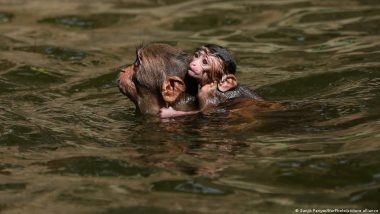From Canada to Australia, animals are dying and suffering as heatwaves become more common.Dehydrated howler monkeys falling from trees in Mexico. Billions of mussels, oysters and barnacles boiling on the shorelines of Canada. Hundreds of Magellanic Penguins dropping dead in Argentina in a single day.
Also Read | Business News | SportzGuard Receives Best Sports Infrastructure Company Award in Telangana.
These cases from recent years may have happened to different animal species across the world, but they have one thing in common. They were triggered by extreme heat.
Also Read | Entertainment News | ED Summons YouTuber Elvish Yadav in Money Laundering Case.
Temperatures across the globe are rising as economies increasingly pump greenhouse gases into the atmosphere — 2023 was the hottest year on record. And climate change is only making heatwaves more common and more extreme.
The way this affects wildlife depends on several factors: Their geography, whether they are experiencing chronic heat or individual heatwaves and of course what type of animal they are.
Birds and bats falling dead from the sky
In the most extreme cases, the heat can cause mass die-offs.
“This happens especially in already hot and dry areas where animals cannot really take a lot of additional heating,” said Andreas Nord, an ecologist with Lund University in Sweden.
“Australia is a prime example. There we're talking about effects of biblical proportions. So birds and flying foxes literally fall dead from the sky.”
Even if the heat doesn’t kill the wildlife, it can change their behavior in ways that influence the population size.
There is a “potentially more insidious way of dying,” says Eric Ridell, an ecologist with the University of North Carolina at Chapell Hill in the US, that leaves no bodies.
“Perhaps because they're more dehydrated or they can't be active enough because it's too hot, they don't breed that year,” he said. “So the animals still survive, but they're not not creating young.”
A 2023 study found that burying beetles were less likely to reproduce successfully when a heatwave hits during mating.
Adapting to the heat
When animals change the way they act to stay cooler or become warmer, scientists call this thermal regulatory behavior. During heatwaves this can include staying in the shade, going into the water or resting more.
One of the ways koalas in Australia cope with extreme heat is to hug cool tree trunks, for example. Bears in California sometimes take a more unconventional approach and take dips in people’s pools when temperatures soar, videos show.
It’s not clear, however, to what extent animals can change their behavior to keep up with an ever-warming planet.
“We don't really kn
Agency News
Deutsche Welle|
Jul 10, 2024 02:10 PM IST
From Canada to Australia, animals are dying and suffering as heatwaves become more common.Dehydrated howler monkeys falling from trees in Mexico. Billions of mussels, oysters and barnacles boiling on the shorelines of Canada. Hundreds of Magellanic Penguins dropping dead in Argentina in a single day.
Also Read | Business News | SportzGuard Receives Best Sports Infrastructure Company Award in Telangana.
These cases from recent years may have happened to different animal species across the world, but they have one thing in common. They were triggered by extreme heat.
Also Read | Entertainment News | ED Summons YouTuber Elvish Yadav in Money Laundering Case.
Temperatures across the globe are rising as economies increasingly pump greenhouse gases into the atmosphere — 2023 was the hottest year on record. And climate change is only making heatwaves more common and more extreme.
The way this affects wildlife depends on several factors: Their geography, whether they are experiencing chronic heat or individual heatwaves and of course what type of animal they are.
Birds and bats falling dead from the sky
In the most extreme cases, the heat can cause mass die-offs.
“This happens especially in already hot and dry areas where animals cannot really take a lot of additional heating,” said Andreas Nord, an ecologist with Lund University in Sweden.
“Australia is a prime example. There we're talking about effects of biblical proportions. So birds and flying foxes literally fall dead from the sky.”
Even if the heat doesn’t kill the wildlife, it can change their behavior in ways that influence the population size.
There is a “potentially more insidious way of dying,” says Eric Ridell, an ecologist with the University of North Carolina at Chapell Hill in the US, that leaves no bodies.
“Perhaps because they're more dehydrated or they can't be active enough because it's too hot, they don't breed that year,” he said. “So the animals still survive, but they're not not creating young.”
A 2023 study found that burying beetles were less likely to reproduce successfully when a heatwave hits during mating.
Adapting to the heat
When animals change the way they act to stay cooler or become warmer, scientists call this thermal regulatory behavior. During heatwaves this can include staying in the shade, going into the water or resting more.
One of the ways koalas in Australia cope with extreme heat is to hug cool tree trunks, for example. Bears in California sometimes take a more unconventional approach and take dips in people’s pools when temperatures soar, videos show.
It’s not clear, however, to what extent animals can change their behavior to keep up with an ever-warming planet.
“We don't really know that if say 100, 1,000 or 10,000 generations from now animals will be more heat adapted or more tolerable to these extreme temperature fluctuations that we're seeing,” said Nord. “But it's not looking good. It seems like many animals are already living on the maximum of what their physiological systems can tolerate.”
Birds are especially vulnerable
Another open question is which species are the most susceptible to rising temperatures. While there are many groups that are suffering, scientists have observed that birds are often especially vulnerable.
“They have, comparatively speaking, relatively poor ways of cooling their bodies. Birds lack sweat glands. That is a very bad thing when it gets very hot,” said Nord.
That is also something Riddell observed in a 2021 study he authored. The research analyzed a 100-year data set of small mammals and birds found in the Mojave Desert in California.
Though the two communities lived in the same ecosystem, eating the same food and drinking the same water, they had different responses to rising temperatures.
The mammal communities stayed stable throughout the century. Meanwhile, the number of bird species in the desert dropped by 43%.
It’s not clear if the birds migrated to other environments or if they died. But it is clear that they are at a disadvantage when temperatures rise.
“Mammals largely live underground, they're mostly nocturnal, and birds are mostly diurnal, live above ground. They're experiencing the sun, which really heats them up,” said Riddell. “These differences played a really big role in responses to climate change over the last 100 years.”
Thinking long-term
There are few emergency interventions that humans can undertake to help animals cope with extreme heat. Some conservationists have tried to help wildlife by spraying them with water or providing shelter. But this is only a band-aid on a much larger problem.
What is even more important looking forward is for governments to conserve natural habitats long-term, say Nord and Riddell. Because the animals’ natural environments will have the resources to buffer the worst effects of scalding temperatures. That could be shady trees, water, nourishment, places to seek refuge.
“This effect that climate change and extreme heat has on the living world really gets worse the less of the living world that we have left,” said Nord.
Edited by Tamsin Walker
Sources:
Exposure to climate change drives stability or collapse of desert mammal and bird communities https://www.science.org/doi/10.1126/science.abd4605
The consequences of heatwaves for animal reproduction are timing-dependent https://besjournals.onlinelibrary.wiley.com/doi/10.1111/1365-2435.14386
The unprecedented Pacific Northwest heatwave of June 2021 https://www.nature.com/articles/s41467-023-36289-3
Unprecedented heat mortality of Magellanic Penguins https://academic.oup.com/condor/article/124/1/duab052/6497508
(The above story first appeared on LatestLY on Jul 10, 2024 02:10 PM IST. For more news and updates on politics, world, sports, entertainment and lifestyle, log on to our website latestly.com).













 Quickly
Quickly













 LSG
LSG



